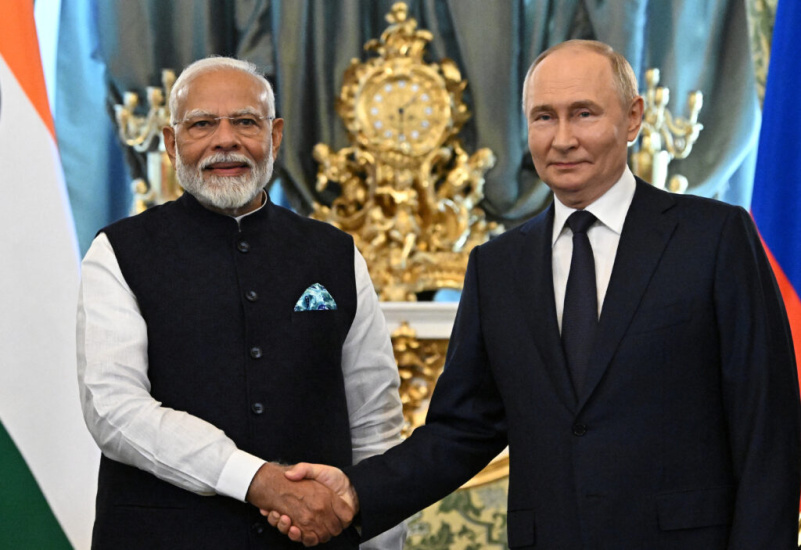Russian-Indian Relations, an Opportunity for Iran

Modi's visit to Moscow in June might have come as a surprise and shock for many, especially to India's Western partners, but the outcome of his visit could provide a chance for two global powers to expand ties as well as providing an opportunity for another international actor, Iran, one of the missing chain links in Russian-Indian relations is Iran and Iran's role in the International North-South Transit Corridor. The result of this visit was that both Russia and India set a goal of annual trade of 100 billion USD, a lucrative economic opportunity also for Iran.
Modi's visit to Moscow was his first visit after being elected for a third term as prime minister. His visit and meeting with Russian president, Vladimir Putin came as a shock and disappointment to many, including Vlodymyr Zelesnsky, whom hoped India would act as a mediator for the Russian Ukrainian War which started in 2022. Even though Modi's meeting had been overshadowed by the fact the US and its partners had strived to isolate Russia from the international community, the visit between the two had in some manner cast a shadow on the 75th NATO summit and anniversary.
Despite the fact that Russian-Indian relations is a continuation of 50 years of strategic cooperation and in line with India's strategic autonomy, since the start of the 2022 Russian-Ukrainian War, Russia has found India to be a reliable partner when it comes to purchase of Russian oil at a time when Russia was slapped with numerous sanctions.
Since the start of the Russian-Ukrainian War which increased the partnership between the two countries, it also provided the opportunity for another third party, Iran. According to sources, the amount of trade that was recorded between Russia and India traversed through a dormant corridor that was reactivated after 20 years. This corridor known as the North-South Corridor is a corridor which was signed between the three parties of Russia, Iran and India in 2001.
Russia has tried to offset the economic and international pressures caused by the war, has exported oil to India at a low price. With the start of Russian exports to India, we have also witnessed an increase in Iranian imports. Iran also shares a similar situation to Russia due to the longstanding tensions and feud between Iran and the USA over a variety of reasons, one being Iran's nuclear issue.
Iran is geographically located at the crossroads of Asia, Africa and Europe. It connects South Asia, Central Asia to West Asia, the Caucasus and the Middle Eastern-North African (MENA) Region. Since 2001, during the Khatami Government, Russia, Iran, India and the Republic of Azerbaijan which would allow India and Russia access by using Iran as transit hub. As of 2024, the projects in which will finalize this transit route will near completion, giving Iran a strategic edge and advantage compared to other countries in the region. As of 2024, India has allocated funds in developing the ports of Chabahar, recently Iran's Ministry of Roads and Transportation signing a 10 year contract with India Ports Global Limited in developing the port further one week prior to the death of Iran's former president, Ebrahim Raisi. With the election of Masoud Pezeshkian as president who will take office in August, it is expected that Iran-India relations to further transform into a more strategic one.
Iran, which has been under years of US led sanctions, has developed ties with Russia through the development of the INSTC as well as China through a 25 year strategic partnership agreement, much to the concern of India. Even though Iran has developed close ties with Russia and China, it also seeks to expand ties with India for a number of reasons. One is that India due to its cultural and linguistic closeness and economic trade with Iran has in times worked on the behalf of Iran in receiving exemptions from the US in developing Chabahar. One example can be seen in 2017, after the withdrawal of the US from the JCPOA or Iran Deal during the administration of US president, Donald Trump. Chabahar as a port also allows for it to act as a counter to China's OBOR. An issue the US is willing to make an exception when it comes to India.
Not only does Chabahar connect India to Russia and the Caucasus but it also allows access and connectivity to Central Asia as well as India access to the Caucasus and Turkey which eventually leads to Europe. One example of Iran which can act as a hub and conduit can be Turkey's objection to the India-Middle East Economic Corridor (IMEC) in which objected as circumventing Turkey, allowing for Iran to also act as a mediating point for both India and Turkey. India's presence in Chabahar also allows for Iran to diversify international and foreign investment in developing infrastructure to promote economic growth. It is also mentionable that India's strategic and closeness to the US also allows Iran to better manage its relations with the US and the West at a time which is predicted that under the new government Iran might be seeking in reaching a deal with the US in which India as a mediator.
On the other hand Iran's location which provides access for India to Russia, Iran's relationship with China as well as Pakistan can also be the basis for Iran to act both as an economic and diplomatic mediator as well. If operational, Iran-India relations can develop further into a more strategic one.
* Farzan Safari Sabet is PhD Student of Indian Studies at the Faculty of World Studies, University of Tehran, and his Master's thesis was Chabahar Role in Indo-Iranian Relations: Opportunities, Challenges and Prospects from 2015 to 2020. Currently focuses on Iran-India relations as well as US factor in Iran-India relations and China-India relations.

